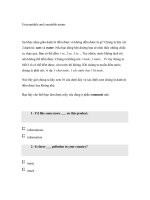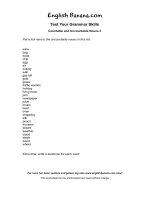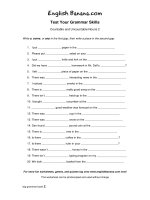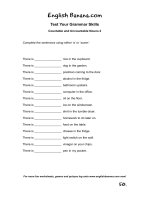Countable nouns
Bạn đang xem bản rút gọn của tài liệu. Xem và tải ngay bản đầy đủ của tài liệu tại đây (10.75 KB, 1 trang )
Countable nouns
Countable nouns are the names of objects, people and places that can be counted. Examples are: flower, boy,
apple, book, tree, room, house, window etc.
Countable nouns have singular and plural forms and can be used with indefinite articles (a / an) and numbers.
Generally, a singular countable noun always takes an article or another determiner with it.
I saw a boy in the store. (BUT NOT I saw boy in store.)
The child was playing with his toy. (BUT NOT Child was playing with toy.)
A plural noun can be used with or without an article.
Children were playing in the park. (This style is preferred when you don’t expect the listener to know
which children you are talking about.)
OR The children were playing in the park. (This style is preferred when you are talking about children
who have already been mentioned.)
Uncountable nouns refer to objects or ideas that cannot be counted. Examples are: rice, sand, milk, honey,
honesty, integrity etc.
Uncountable nouns cannot be used with numbers. It is also not possible to use the articles a / an with
uncountable nouns.
Uncountable nouns are always singular and should be used with a singular verb.
Honesty is the best policy. (NOT Honesty are the best policy.)
Rice is the staple food of Indians. (NOT Rice are the staple food of Indians.)
Note that some nouns which are countable in one language can be uncountable in another language. For
example, the word grapes is a plural countable noun in English. However, it is uncountable in many other
languages.
Stay on top of your writing! Download our grammar guide from www.englishgrammar.org to stay up-to-date.
Powered by TCPDF (www.tcpdf.org)









